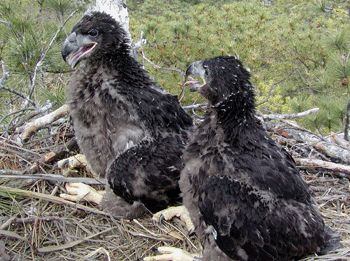July 8, 2009
Center for Conservation Biology invites the public to become involved in eagle conservation as the Virginia breeding population continues to climb
Share this story

The Center for Conservation Biology at the College of William and Mary and Virginia Commonwealth University has developed a Virginia eagles Web site that hosts a Google map application allowing users to locate documented eagle nests and to view their mapped locations on a county-by-county basis.
For the first time in the 54-year history of the annual bald eagle survey, the locations of known nests are being made available online to the public. The results of the 2009 survey are being made available in the hope that the public will become more actively involved in the conservation of this species throughout Virginia.
“We believe that breeding sites may be better protected in the long term if they are known to the public,” said Bryan Watts, Ph.D., director of the Center for Conservation Biology. “Despite our best efforts, an unknown number of eagle nests go unrecorded each year.
“This is particularly true in the Piedmont and mountains of Virginia where there is no survey effort,” Watts said. “We believe that the public knows of many nests that are unknown to us. We are requesting that the public view nests in their locality and report nests that are currently not included in the annual survey.”
The center has compiled 2009 survey results for the Virginia bald eagle population. The number of known breeding pairs has increased nearly 5 percent from 584 pairs in 2008, to 612 pairs in 2009. This is the highest number of breeding pairs ever recorded in the state.
Despite widespread and early nest failures caused by a strong storm during the peak of incubation, pairs recovered and produced 826 chicks. Chick production was second only to the record 2008 season, Watts said. Since 2000, 6,240 chicks have been documented in the state. The upper reaches of the James and Rappahannock Rivers continue to provide the most significant breeding habitat for bald eagles in Virginia.
For more information on the center and the collaboration between The College of William and Mary and VCU, visit http://www.vcu.edu/insidevcu/0901collaboration/index.html.
Subscribe to VCU News
Subscribe to VCU News at newsletter.vcu.edu and receive a selection of stories, videos, photos, news clips and event listings in your inbox.










